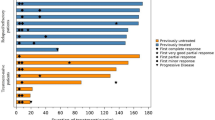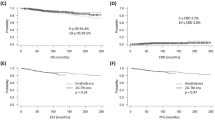Abstract
The introduction of single-agent rituximab has markedly changed the approach to therapy of patients with post-transplantation lymphoproliferative disorder (PTLD), but response to treatment varies substantially between patients. In the current report, we analyze long-term efficacy of single-agent rituximab in 60 patients and present factors predictive of progression-free and overall survival. Twelve months after completing first-line treatment, 34 of 60 patients (57%) had progressive disease, resulting in a median progression-free survival of 6.0 months at a median follow-up of 16.3 months. Using multivariate Cox regression analysis, the following factors were identified as significantly predictive of overall survival: age at diagnosis, performance status, lactate dehydrogenase (LDH), and time from transplantation to PTLD. Stage of disease and Epstein–Barr virus association of PTLD did not influence overall survival. LDH and time from transplantation to PTLD were also predictive of progression-free survival. The international prognostic index was shown to be of limited predictive value in these patients, but a PTLD-specific prognostic index separated low-, intermediate-, and high-risk patients with high significance: 2-year overall survival rates after first-line treatment with single-agent rituximab were 88, 50, and 0%, respectively. Thus, prognostic indices can be useful tools for prediction of treatment outcome and for the development of risk-adapted treatment strategies in patients with PTLD and may also provide the basis for interstudy comparisons.


Similar content being viewed by others
References
Penn I, Hammond W, Brettschneider L, Starzl TE (1969) Malignant lymphomas in transplantation patients. Transplant Proc 1:106–112
Dodd GD III, Greenler DP, Confer SR (1992) Thoracic and abdominal manifestations of lymphoma occurring in the immunocompromised patient. Radiol Clin North Am 30(3):597–610
Pickhardt PJ, Siegel MJ (1999) Posttransplantation lymphoproliferative disorder of the abdomen: CT evaluation in 51 patients. Radiology 213(1):73–78
Dotti G, Fiocchi R, Motta T et al (2002) Lymphomas occurring late after solid-organ transplantation: influence of treatment on the clinical outcome. Transplantation 74(8):1095–1102
Bakker NA, van Imhoff GW, Verschuuren EA et al (2005) Early onset post-transplant lymphoproliferative disease is associated with allograft localization. Clin Transplant 19(3):327–334
Harris NL, Ferry JA, Swerdlow SH (1997) Posttransplant lymphoproliferative disorders: summary of Society for Hematopathology Workshop. Sem Diagn Pathol 14(1):8–14
Leblond V, Dhedin N, Mamzer Bruneel MF et al (2001) Identification of prognostic factors in 61 patients with posttransplantation lymphoproliferative disorders. J Clin Oncol 19(3):772–778
Tsai DE, Hardy CL, Tomaszewski JE et al (2001) Reduction in immunosuppression as initial therapy for posttransplant lymphoproliferative disorder: analysis of prognostic variables and long-term follow-up of 42 adult patients. Transplantation 71(8):1076–1088
Starzl TE, Nalesnik MA, Porter KA et al (1984) Reversibility of lymphomas and lymphoproliferative lesions developing under cyclosporin-steroid therapy. Lancet 1(8377):583–587
Oertel SH, Anagnostopoulos I, Hummel MW, Jonas S, Riess HB (2002) Identification of early antigen BZLF1/ZEBRA protein of Epstein–Barr virus can predict the effectiveness of antiviral treatment in patients with post-transplant lymphoproliferative disease. Br J Haematol 118(4):1120–1123
Mentzer SJ, Perrine SP, Faller DV (2001) Epstein–Barr virus post-transplant lymphoproliferative disease and virus-specific therapy: pharmacological re-activation of viral target genes with arginine butyrate. Transpl Infect Dis 3(3):177–185
Mamzer-Bruneel MF, Lome C, Morelon E et al (2000) Durable remission after aggressive chemotherapy for very late post-kidney transplant lymphoproliferation: a report of 16 cases observed in a single center. J Clin Oncol 18(21):3622–3032
Swinnen LJ, Mullen GM, Carr TJ, Costanzo MR, Fisher RI (1995) Aggressive treatment for postcardiac transplant lymphoproliferation. Blood 86(9):3333–3340
Choquet S, Trappe R, Leblond V, Jaeger U, Davi F, Oertel S (2007) CHOP-21 for the treatment of post-transplant lymphoproliferative disorders (PTLD) following solid organ transplantation. Efficacy, toxicity and factors predicting survival: a retrospective study of 26 cases with a long term follow up of 8.8 years. Haematologica 92:273–274
Svoboda J, Kotloff R, Tsai DE (2006) Management of patients with post-transplant lymphoproliferative disorder: the role of rituximab. Transpl Int 19(4):259–269
Feugier P, Van Hoof A, Sebban C et al (2005) Long-term results of the R-CHOP study in the treatment of elderly patients with diffuse large B-cell lymphoma: a study by the Groupe d’Etude des Lymphomes de l’Adulte. J Clin Oncol 23(18):4117–4126
Pfreundschuh M, Trumper L, Osterborg A et al (2006) CHOP-like chemotherapy plus rituximab versus CHOP-like chemotherapy alone in young patients with good-prognosis diffuse large-B-cell lymphoma: a randomised controlled trial by the MabThera International Trial (MInT) Group. Lancet Oncol 7(5):379–391
Garrett TJ, Chadburn A, Barr ML et al (1993) Posttransplantation lymphoproliferative disorders treated with cyclophosphamide-doxorubicin-vincristine-prednisone chemotherapy. Cancer 72(9):2782–2785
Norin S, Kimby E, Ericzon BG et al (2004) Posttransplant lymphoma–a single-center experience of 500 liver transplantations. Med Oncol 21(3):273–284
Elstrom RL, Andreadis C, Aqui NA et al (2006) Treatment of PTLD with rituximab or chemotherapy. Am J Transplant 6(3):569–576
Buell JF, Gross TG, Hanaway MJ et al (2005) Chemotherapy for posttransplant lymphoproliferative disorder: the Israel Penn International Transplant Tumor Registry experience. Transplant Proc 37(2):956–957
Jain AB, Marcos A, Pokharna R et al (2005) Rituximab (chimeric anti-CD20 antibody) for posttransplant lymphoproliferative disorder after solid organ transplantation in adults: long-term experience from a single center. Transplantation 80(12):1692–1698
Oertel SH, Verschuuren E, Reinke P et al (2005) Effect of anti-CD 20 antibody rituximab in patients with post-transplant lymphoproliferative disorder (PTLD). Am J Transplant 5(12):2901–2906
Choquet S, Leblond V, Herbrecht R et al (2006) Efficacy and safety of rituximab in B-cell post-transplant lymphoproliferative disorders: results of a prospective multicentre phase II study. Blood 107:3053–3057
Ghobrial IM, Habermann TM, Ristow KM et al (2005) Prognostic factors in patients with post-transplant lymphoproliferative disorders (PTLD) in the rituximab era. Leuk Lymphoma 46(2):191–196
Choquet S, Levy V, Leblond V (2004) Identification of prognostic factors in post-transplantation lymphoproliferative disorders. Bull Cancer 91(4):373–378
Czuczman MS, Grillo-Lopez AJ, Alkuzweny B, Weaver R, Larocca A, McLaughlin P (2006) Prognostic factors for non-Hodgkin’s lymphoma patients treated with chemotherapy may not predict outcome in patients treated with rituximab. Leuk Lymphoma 47(9):1830–1840
Buske C, Hoster E, Dreyling M, Hasford J, Unterhalt M, Hiddemann W (2006) The Follicular Lymphoma International Prognostic Index (FLIPI) separates high-risk from intermediate- or low-risk patients with advanced-stage follicular lymphoma treated front-line with rituximab and the combination of cyclophosphamide, doxorubicin, vincristine, and prednisone (R-CHOP) with respect to treatment outcome. Blood 108(5):1504–1508
Coiffier B, Lepage E, Briere J et al (2002) CHOP chemotherapy plus rituximab compared with CHOP alone in elderly patients with diffuse large-B-cell lymphoma. N Engl J Med 346(4):235–242
Trappe R, Oertel SH, Choquet S, LeBlond V, Papp-Vary M, Riess H (2005) Sequential treatment with the anti-CD 20 antibody rituximab and CHOP + GCSF chemotherapy in patients with post-transplant lymphoproliferative disorder (PTLD): first results of a multicenter phase II study. Blood (ASH Annual Meeting Abstracts) 106(11):932
Plosker GL, Figgitt DP (2003) Rituximab: a review of its use in non-Hodgkin’s lymphoma and chronic lymphocytic leukaemia. Drugs 63(8):803–843
Oertel S, Trappe RU, Zeidler K et al (2006) Epstein–Barr viral load in whole blood of adults with posttransplant lymphoproliferative disorder after solid organ transplantation does not correlate with clinical course. Ann Hematol 85(7):478–484
Bakker NA, Verschuuren EA, Erasmus ME et al (2007) Epstein–Barr virus-DNA load monitoring late after lung transplantation: a surrogate marker of the degree of immunosuppression and a safe guide to reduce immunosuppression. Transplantation 83(4):433–438
Acknowledgments
All authors are member of the European Study Group on PTLD and gratefully acknowledge the cooperation with the Competence Network Malignant Lymphomas (KML) and the German Study Group on PTLD (DSPTLDSG).
Author information
Authors and Affiliations
Corresponding author
Additional information
Sylvain Choquet and Stephan Oertel contributed equally in this paper.
Rights and permissions
About this article
Cite this article
Choquet, S., Oertel, S., LeBlond, V. et al. Rituximab in the management of post-transplantation lymphoproliferative disorder after solid organ transplantation: proceed with caution. Ann Hematol 86, 599–607 (2007). https://doi.org/10.1007/s00277-007-0298-2
Received:
Accepted:
Published:
Issue Date:
DOI: https://doi.org/10.1007/s00277-007-0298-2




